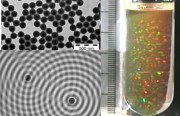Stages of film formation
Film formation from latex dispersions
For environmental as well as economic reasons there was a trend in the past 30 years to refrain from volatile organic compounds (VOC) in paints and coatings. A purely water based dye can be bought today in every DIY store and the principle it's based on is called film formation from aqueous latex. In general it is assumed that the film formation can be separated in the following four stages:
Stage 1:
Water evaporates and thus polymer particles become concentrated, finally forming a dense closed packing.
Stage 2:
For temperatures above the minimal film forming temperature (MFT, ~ glass transition temperature of the polymer) the particles deform.
Stage 3:
Now, it comes to the breakage of the interfaces which consist of hydrophilic material (surfactant, salts and water).
Stage 4:
For temperatures above the glass transition temperature polymer chains start to interdiffuse forming a mechanical stable film. Depending on the film forming conditions and chosen dispersion the hydrophilic material of the broken interfaces is either heterogeneously distributed in the film or exuded to the film/air and film/substrate interfaces.

